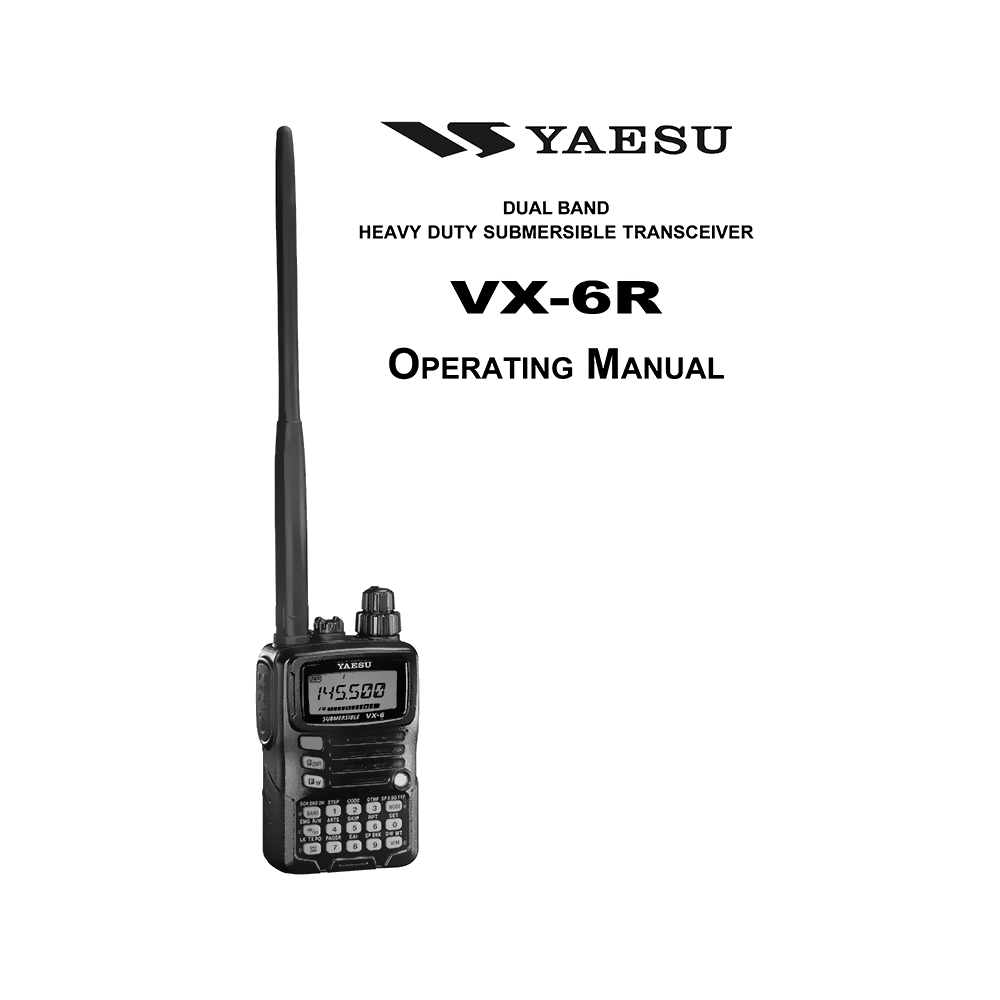Yaesu VX-6R Dual Band Transceiver Operating Manual
Download PDF user and service manuals for Vertex Standard / Yaesu VX-6R Dual Band Heavy Duty Submersible Transceiver (EN) 112+56 pages EH021M100, EH021M90A 2005 zip
Description
These PDF operating and service manuals are for the Yaesu VX-6R Dual-Band Heavy Duty Submersible Transceiver.
About the Item
Yaesu VX-6R Dual Band Heavy Duty Submersible Transceiver
The VX-6R is a dual band heavy duty submersible transceiver with extensive receive frequency coverage, providing local-area two-way amateur communications along with unmatched monitoring capability.
The VX-6R’s small size allows you to take it anywhere – hiking, skiing, or while walking around town – and its operating flexibility brings the user many avenues of operating enjoyment.
Its incredibly compact FNB-80LI Rechargeable Lithium Ion Battery Pack provides up to 5 Watts of transmit power on 144 MHz and 430 MHz Amateur Bands. Besides 144- and 430-MHz transceive operation, the VX-6R provides receive coverage of the AM (MF) and FM broadcast bands, HF Shortwave Bands, VHF and UHF TV bands, the VHF AM aircraft band, and a wide range of commercial and public safety frequencies! Further more, the USA version enables 1.5 Watts of transmitted power on the 222 MHz Amateur Band.
We encourage you to read this manual thoroughly, so as to learn about the many exciting features of your exciting new Yaesu hand-held transceiver!
Document(s) available
(PDF) OPERATING MANUAL
Available languages
ENGLISH (EN)
SUMMARY OF CONTENTS
– General Description
– Accessories & Options
– Controls & Connections: Top & Front Panel, LCD, Side & Bottom Panel, Keypad
– Installation of Accessories: Antenna Installation, Belt Clip & Hand Strap Installation, Installation of FNB-80LI Battery Pack, Battery Charging, Installation of FBA-23 Battery Case, Low Battery Indication
– Interface of Packet TNCs
– Operation: Switching Power On and Off, Adjusting the Volume Level, Squelch Adjustment, Selecting the Operating Band, Frequency Navigation, Transmission, Changing the Transmit Power Level, Changing the Microphone Gain Level, AM Broadcast Reception, AM Aircraft Reception, FM Broadcast/TV Audio Reception
– Advanced Operation: Keyboard Locking, Adjusting the Keypad Beeper Volume Level, Keypad/LCD Illumination, Changing the Channel Steps, Changing the Receiving Mode, RF Squelch, Checking the Battery Voltage
– Repeater Operation: Repeater Shifts, Automatic Repeater Shift (ARS), Manual Repeater Shift Activation
– CTCSS/DCS Operation: CTCSS Operation, DCS Operation, DCS Code Inversion, CTCSS/DCS Bell Operation, Tone Search Scanning, Split Tone Operation, Tone Calling (1750 Hz)
– Memory Mode: Memory Storage, Storing Independent Transmit Frequencies (“Odd Split”), Memory Recall, Labeling Memories, Memory Offset Tuning, Moving Memory Data to the VFO, Masking Memories, Memory Only Mode, HOME Channel Memory, Memory Bank Operation, Direct Memory Recall Channel, Short-Wave Broadcast Station Memory Channels, Weather Broadcast Channels, VHF-Marine Channels
– Scanning: VFO Scanning, Setting the Squelch Level during activate Scanning Opertion, How to Skip (Omit) a Frequency during VFO Scan, Memory Scanning, How to Skip (Omit) a Channel during Memory Scan, Preferential Memory Scan, Memory Bank Scan, Programmable (Band Limit) Memory Scan (PMS), “Priority Channel” Scanning (Dual Watch), Automatic Lamp Illumination on Scan Stop, Band Edge Beeper, Weather Alert Scan
– Smart Search Operation
– Channel Counter Operation
– EPCS (Enhanced Paging & Code Squelch): Storing the CTCSS Tone Pairs for EPCS Operation, Activating the Enhanced Paging & Code Squelch System, Paging Answer Back
– Emergency Feature: Emergency Channel Operation, Emergency Automatic ID (EAI) Feature, Selecting the EAI mode and its Transmit Time, Activating the EAI feature, To Locate an Unresponsive Operator Using the EAI Feature
– ARTS(TM) (Automatic Range Transponder System)
– Sensor Mode: To display the Temperature, To display the Sensor Information, Selecting and Correcting the Atmospheric Pressure Meter, Selecting and Correcting the Altimeter
– Internet Connection Feature: SRG (“Sister Radio Group”) Mode, FRG (“Friendly Radio Group”) Mode
– DTMF Operation: Manual DTNF Tone Generation, DTNF Autodialer
– CW Training Feature
– Miscellaneous Settings: Password, Programming the “P” Key, Receive Battery Saver Setup, Wakeup Feature Setup, TX Battery Saver, ATT (Front End Attenuator), Disabling the TX/BUSY Indicator, Automatic Power-Off (APO) Feature, Automatic Power-On Feature, Busy Channel Lock-Out (BCLO), Transmitter Time-Out Timer (TOT), Changing the TX Deviation Level
– Reset Procedures
– Cloning
– Set (Menu) Mode
– Specifications
– “AUTO” Mode Preset Operating Parameters
TECHNICAL SUPPLEMENT (SERVICE MANUAL) EH021M90A
This manual provides the technical information necessary for servicing the VX-6R Dual-Band Heavy Duty Submersible Transceiver.
Servicing this equipment requires expertise in handing surface-mount chip components.
CONTENTS:
– Specification
– Exploded View & Miscellaneous Parts
– Block Diagram
– Interconnection Diagram
– Circuit Description
– Alignment
– Board Unit (Schematics, Layouts & Parts): CNTL Unit, AF Unit, RF Unit, VCO Unit
Why Download the Manuals?
These operating and service manuals provide all the information from Vertex Standard Yaesu about the VX-6R Transceiver, as detailed in the tables of contents. Reading them completely will address most questions you might have. You can download and save them for offline use, including viewing them on your device or printing them for your convenience if you prefer a paper version.
How to Download the Manuals?
Download it by clicking the button below
Helped you out?
Glad to hear that. It would be awesome if you could . . .


